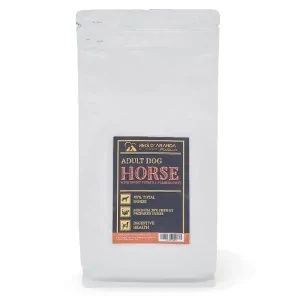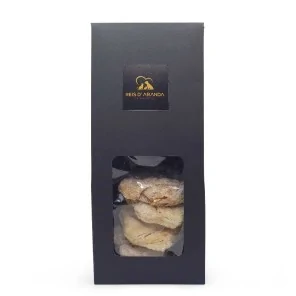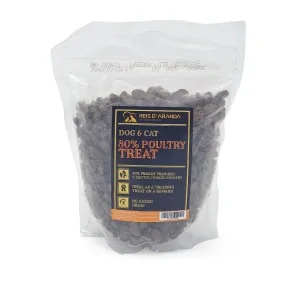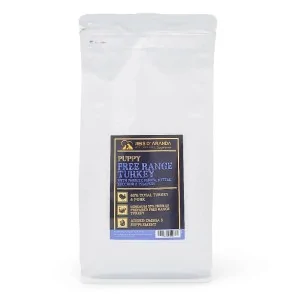Its name says it all: the Vienna blue rabbit comes from Austria. Not only is it beautiful with its shiny blue-grey...
THE MALLORCAN SHEPHERD DOG
INTRODUCTION
The Mallorcan Shepherd Dog or Ca de Bestiar is a Spanish breed of dog originating in Mallorca. Traditionally used in the Mallorcan countryside as a flock guardian, it has a distinctive black coat.
THE HISTORY OF THE MALLORCAN SHEPHERD DOG
The origins of the Ca de Bou breed, as with most ancient dog breeds, are somewhat unclear. If we have to look for an origin for this breed, it has to be through the Spanish Alano or Presa type dogs that arrived in Mallorca in 1229 with King Jaime I.
Once Mallorca was conquered, they settled down, crossing with other autochthonous dogs, thus forming a group of dogs of prey, the use of which was basically the work with cattle and the guarding of people and property. As early as the 13th century, the Guild of Butchers used these dogs as assistants to the butchers or slaughterers for the slaughter of livestock, due to their powerful grip and the strength of their jaws.
This breed was also used in the 13th, 14th and 15th centuries to hunt wild boar and deer, which were abundant in Mallorca at that time, and was also used in the 15th, 16th and 17th centuries by bandits and highwaymen and their pursuers to capture them. Over the years, this population of dogs of prey had to cross, not only circumstantially but also premeditatedly, with another racial grouping, equally defined as the previous one and whose work was basically that of herding sheep, seeking in these crossings to improve the functionality of both groupings, the result being very possibly the embryo of the modern Ca de Bou.
THE STANDARD OF THE MALLORCAN SHEPHERD DOG
GENERAL APPEARANCE: Dog of subconvex profile, of large size without being exaggerated and of medium weight. Completely black or black with white patch on chest, well proportioned, rustic, strong, muscular, robust and agile. There are two varieties of coat:
- Shorthair, the most common variety.
- Long coat.
IMPORTANT PROPORTIONS: Sub-hypermetric, mediolinear and subconvex dog.
- In bitches a longitudinal diameter up to 3% greater than the height at the withers is acceptable.
- Length of muzzle equal to length of skull.
- The length of the head should be equal to the length of the neck.
- In adult males the thoracic perimeter, taken from the withers behind the elbows, is approximately a few centimetres more than the height at the withers.
HEAD: Slightly triangular in profile; seen from the back, broader at the top than at the bottom; massive, but not heavy; broad enough to accommodate a good intelligence; well moulded and in proportion to the body; should be rather large, but never of the molosser type. The supranasal line is parallel to the cranial line. Cranio-facial axes slightly divergent.
CRANIAL REGION:
SKULL: Profile subconvex. The width of the head, taken between the temporals, should be slightly superior (approximately 1,2 %) to the length between the supraorbital line and the occipital crest. A slight furrow may be visible in the first third of the frontal midline. Occipital crest marked.
STOP: Marked, but never abrupt, gently sloping.
FACIAL REGION:
TRUFFLE: Moist, fresh, black, large, with wide nostrils; not parted. It will be noticeably blunt if it is barred or lighter in colour. Muzzle: Broad, rather strong; should not be pointed, but should be accentuated in height and width as it approaches the orbits.
In the variety ‘Ca cabrer’ (long hair) it is more pointed. The dorsal profile of the muzzle is subconvex. The profile of the branches of the lower jaw is straight. Palate black.
LIPS: Black; the upper lip does not show the lower lip when the mouth is closed; the labial commissure is not very noticeable and unnoticed as they are well proportioned to the head.
TEETH : Teeth very white, well developed and well placed, scissor bite, the upper extreme incisors making a real catch with the lower canines. Molars well developed.
EYES: Rather small in size, slightly almond-shaped, neither prominent nor sunken into the orbits, not too wide apart, centred, slightly oblique, lively. Colour between that of rosemary honey (somewhat light) and carob honey (dark). Enigmatic expression, with an intelligent yet sad look, even a hint of mistrust.
The eyelids are thin, black and oblique, close fitting to the eye.
EARS: Broken, of small size in relation to the head, triangular, reaching the tip of the tear trough of the eye on the corresponding side, i.e. approximately equal to the length of the skull. Undocked, somewhat thick, set on high, slightly separating at the tip from the skull, with a longitudinal fold and a transverse fold around the first third. Position of the ears: Normally folded and drooping, slightly set back from the muzzle. Set back in state of rest; in state of attention raised by the transverse fold, set back from the muzzle more than usual.
NECK: Solid, muscular, strong and in proportion to head and body. Thick, with very little dewlap, cylindrical, its diameter becoming more accentuated at the base. The skin is hard and elastic, neither thin nor thick, well attached to the neck at the top and sides, somewhat more detached at the bottom.
BODY:
GENERAL APPEARANCE: Robust, very well proportioned, giving at the same time impression of strength and agility.
CROSS: Well defined and at least at the same height as the upper part of the croup; the area between the shoulder blades broad and strong.
DORSO-LUMBAR LINE: Straight, horizontal, never saddled.
LOIN: Broad and powerful.
Croup: Medium sized, slightly rounded, broad, powerful and muscular, never prominent or drooping. The upper part should be at the same height as the withers. Its inter-iliac width should be equal to the iliac-ischial length.
CHEST: Broad and high, reaching at most to elbow level; of a width approximately equal to the length of the neck; fairly deep, not prominent, with a slightly pronounced sternum.
Ribs arched (not flat or barrel shaped).
BELLY AND FLANKS: Flanks moderately voluminous. Belly slightly tucked up, never tucked up, never lowered so as to be confused with the continuation of the brisket. Somewhat slender, should give the impression of agility.
TAIL: Set on horizontally and circular in section, rather thick at the root. At about 8 cm from its base it flattens out slightly in its lower profile, for about 10 cm of its length, to continue then the decreasing circular section to its end. Without amputation. Of a length which must reach at least to the hock, without ever touching the ground.
Without tuft or fringe, although it is permitted, if it is light, in older dogs. In the long-haired variety the fringe should be abundant and long. Carriage of the tail: In repose naturally drooping or slightly curved outwards, slightly touching the hocks, its tip touching the ground being considered a serious fault. Sickle-shaped, wavy and raised above the horizontal, without curl, when in action.
LIMBS
FOREQUARTERS:
GENERAL APPEARANCE: Strong limbs; correct verticality; seen from the front and in profile parallel to each other and perpendicular to the ground.
Shoulders: Oblique and strong.
ARMS: Of equal length to the shoulder blade.
ELBOWS: Without deviation, close to the chest.
FOREARMS: Strong, well angulated, perpendicular. Bones vertical, strong, long and straight.
Pastern: Short and slightly sloping.
HANDS: Almost hare-like (slightly shorter and broader than the latter), with semi-long, semi-arched, close-fingered toes with very hard, black pads. Without accentuated interdigital membrane.
HIND LIMBS:
GENERAL APPEARANCE: Muscular, strong, with correct proportions. Muscular relief attenuated and hard.
THIGH: Strong and muscular.
LEG: Long and powerful.
Hock: Slightly pronounced, with a very open angulation of 135°. The height of the hock is approximately a little less than one third of the height at the withers.
METATARSE: Well marked.
FEET: Almost hare-like, flat, with toes half arched and close together. Pads hard and black. Nails arched, hard and black. Without accentuated interdigital membrane. May be born with or without dewclaws, in the first case they should be amputated.
GAIT/MOVEMENT: Gait should be firm and elegant. The trot should be diagonal bipedal, slightly canting the hind third with respect to the front. The gallop should be frank, fast, rustic, with the hind legs well off the ground at their base, placing them outside the hands, as if jumping. The preferred and working gait is the canter.
SKIN: Elastic, without folds, hard and light grey.
COAT
HAIR: Short and close to the skin, varying in length from 1.5 cm to 3 cm on the back; undercoat very fine, not very thick and very close to the skin. In the long-haired variety it may be slightly wavy on the back, with an approximate length of more than 7 cm depending on the time of year, the longest being in winter. The undercoat is well distributed and not very thick, increasing in normal length on the fringe of the tail, tips of the ears and back of the limbs. In both varieties it should be soft, harsh and quite fine.
COLOUR: The only colour permitted is black, in its jet, ordinary and piebald varieties. White is only permitted on the chest, in the form of a fine tie under the neck and on the front and hind feet, blunting according to its easy visibility on nails and toe tips. The jet black is the most prized, the ordinary black and the peceño being the most prized.
SIZE AND WEIGHT
HEIGHT AT WITHERS:
- Between 66 and 73 cm for the males,
- Between 62 and 68 cm for bitches.
Specimens with heights of one centimetre more or less than the above-mentioned limits are permitted.
In this case, points should be deducted.
WEIGHT: Around 40 kg.
FAULTS: Any departure from the foregoing points should be considered a fault and the seriousness with which the fault should be regarded should be in exact proportion to its degree and its effect upon the health and welfare of the dog.
SERIOUS FAULTS:
- Drooling dogs.
- Cropped tusks.
- Ears too raised in repose, too large, too wide apart from the face or completely close to the face.
- Belly very tucked up (agalgado).
- Tail curled; tip of tail white.
- White chest patch of more than 1 dm².
- All toes white.
DISQUALIFYING FAULTS:
- Aggressiveness or extreme shyness.
- Any dog showing clear signs of physical or behavioural abnormalities.
- Mastiff head, very broad and heavy or sighthound head, long and narrow with barely pronounced stop.
- Nose pink or white.
- Overshot or undershot mouth by more than 3 mm.
- Eyes of different colours from each other; eye not ranging in colour from rosemary honey (somewhat light) to carob honey (dark); eye very light.
- Ears cropped, stiff in action or almost stiff in repose.
- Neck with double dewlap, thicker at the skull than at the base, longer than 10% of the length from the nose to the occipital crest.
- Body too long or too short; height of the upper part of the croup 3% greater than the height at the withers.
- Tail too thick, or of equal thickness at the base and at the tip; excessively long to touch the ground; docked or missing about 2 cm to reach the hock; with abundant fringe in the short-haired variety, or without fringe in the long-haired variety.
- Other colour than black, or, in dogs being black, a white or other coloured front or hind foot; limbs shod in white in any number of limbs; body not entirely black (except for the chest, very few hairs on the belly, perpuce or tip of the tail), the patches of which, without disqualifying, shall be noticeably blunted. White hairs resulting from bites, trauma or other similar injuries, or white hairs on the face which are typical of age, shall not be disqualified. White toes do not disqualify, unless the animal has more than six toes, each of which is noticeably blunted; a single white or other coloured toe on the front feet disqualifies the dog.
- Height at withers over 74 cm for males and over 70 cm for bitches. Height at withers less than 66 cm for males and less than 60 cm for bitches.
- Weight of less than 30 kg and more than 50 kg in males, weight of less than 25 kg and more than 45 kg in females; even within the above limits, very skinny dogs, visibly obese or very saddled (with tolerance in pregnant females).
THE HEALTH OF THE MALLORCAN SHEPHERD DOG
Being a large dog, the Majorcan Shepherd Dog can suffer from hip and elbow dysplasia.
THE PERSONALITY OF THE MALLORCAN SHEEPDOG
The Ca de Bestiar is basically a shepherd dog, but its fidelity and intelligence allow it to carry out guarding and/or defence tasks.
It has always been appreciated in Mallorca for its herding qualities and its physical endurance. It is very affectionate and loyal to the person it considers a friend, although its affection must be earned by treating it well and giving it plenty of exercise.
On the other hand, he does not usually take orders from anyone he does not consider his master and is often slow to accept them even from him. He tends to be suspicious of strangers, and is always alert and watchful. It is a very independent breed, used to being outdoors, and requires a lot of physical exercise and time for training. He is affectionate with children and quite patient with them.
Dog of great nobility, of only one owner who accepts with difficulty the solicitations of strangers. Intelligent, docile, affectionate, extremely shy and reserved in his youth; his sentimentality reaches unsuspected limits. Faithful to his master until death. If we look into his eyes, we get the feeling that he thinks. He is brave and quarrelsome.
CONCLUSION
Our dog, now properly called Ca de Bou, because of his brave and fierce character, was used in bullfighting shows, fighting with bulls, against other dogs and even against wild beasts. Nowadays, our dear friend is used for guarding and companionship, as his excellent family character and balance make him a magnificent companion for children and adults.
Leave a comment
Log in to post comments
















